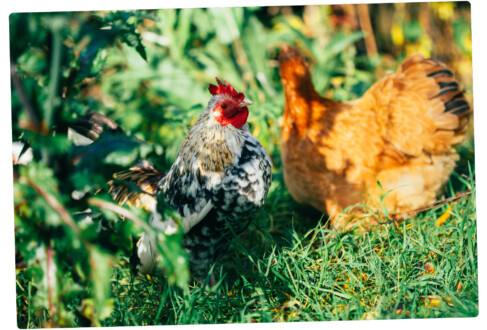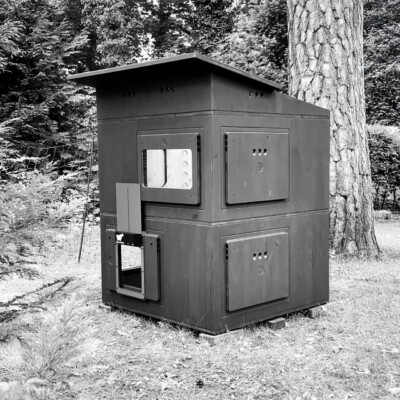You certainly want to keep your chickens in a species-appropriate way and thus enable them to live a stress-free and healthy life. A basic requirement to having happy chickens is that the run replicates their natural habitat as closely as possible. In the wild, fowl such as partridges, pheasants or quails live in the undergrowth of wooded and bushy, and thus densely vegetated, areas.
This means, first and foremost, that open planes are avoided. This is because chickens instinctively do not feel particularly comfortable there. If chickens, for example in a ‘free-range’ setup for egg production, are seen in open areas, this does not mean that they are comfortable – often they simply have no other choice. So instead of being empty, the run should be densely vegetated – and preferably with as varied plant life as possible.
> My TIP: “An appropriately vegetated run also solves another problem for you – if your chickens use the entire run, they will automatically spend less time in the otherwise quickly overused coop.”
To make this more concrete for you, I have divided the minimum requirements into the following areas:
- Minimum size
> at least 10m² per chicken
- Natural food sources
> such as berries, insects, grass or seeds
- Sunny areas
> for sunbathing
- Sheltered, shady areas for resting
> to relax and cool down
- Scratching areas
> to be able to follow the natural instinct to scratch/forage
- Sand baths
> for relaxation and preening
Please note that in addition to these 6 points, there must of course always be sufficient fresh water and grain feed available – this can be inside or outside the coop.

Minimum size
… “the bigger the better” of course applies here:
In any case, your chickens should have enough space in the run. That said, they will nearly always stay in the area immediately around the coop. Even with unlimited freedom of movement they will rarely move more than 50 metres away from it. A run can therefore not be “too big”.
However, if the run is too small, you will run into a variety problems:
- The grass will get completely destroyed by the scratching: when it is dry, a barren area of soil soon forms – when it rains, a mud fight ensues
- Unpleasant odours due to too much excrement in too little space
- Health problems with the chickens
- Injuries to the chickens because they cannot escape from each other if fights start
You will probably not have any of these problems if you follow the following rule of thumb:
> My RULE OF THUMB: “At least 10m² of run per chicken, with large chicken breeds needing a little more space.”
Since the available space is limited in most cases, you should see the number and type of your chickens as the determining factors which need adjusting:
> My TIP: “First consider how much space is available for the run, and only then decide on a suitable species (i.e. size) and number of chickens!”
Natural food sources
… to not always be stuck eating the same old grains:
In order for the run to provide your chickens with healthy food, it must have a good mix of perennials, ornamental grasses, tree roots and other woody plants. A useful addition are stones and other non-plant elements which they will gladly use for climbing, as well as being an indirect food source – namely by attracting insects.
> My EXPERIENCE: “A run that has lots of natural food sources will also noticeably reduce how much you spend on feed!”

Sunny areas
… because chickens enjoy the sun – just like us:
Especially in the colder months, chickens try to get as much sun as possible. Even in high summer, they like to lie directly in the blazing sun for an amount of time, seeming to enjoy sunbathing to the full – just like cats or dogs.
Protected, shady resting areas
… for the midday siesta, especially in summer:
Adequate areas of shade are also essential. Shade provided by plants such as trees, bushes, shrubs, etc. is ideal, because these also create a pleasant, cooling microclimate at ground level. Of course, walls or specially made roof constructions can also provide shade.
> my RECOMMENDATION: “At least one resting area should be setup that provides proper shelter and is always dry and protected from the elements!”
Chickens naturally live in areas where there are trees, bushes and shrubs. However, if and when they are out in the open, e.g. to forage, a nearby sheltered, possibly slightly elevated area is important – somewhere they can quickly retreat to if necessary. The run should therefore offer various hiding places dotted around the place. There the chickens can rest in peace and safety after foraging (i.e. protected from birds of prey in particular).
> My EXPERIENCE: “The more dense the vegetation in the run, the better the chickens are protected from danger from above. We have 2-3 buzzards circling over the garden almost every day. But so far, thanks to an almost complete leafy canopy, we’ve had no incidents with birds of prey.”

Scraping areas
… for scraping and feeding:
Scraping is a deeply primitive instinct of chickens, which is why they should be given ample opportunity to do so. This scraping/scratching instinct, which is always linked to the search for food, can be very hard on the ground. I therefore recommend that you intervene by preparing clearly defined areas in such a way that they invite the chickens to scrape: loosened soil (with regular digging/churning), partly in the sun/partly in the shade, and maybe with some (grain) feed scattered around – though please check the regional legal regulations regarding the feeding of birds outdoors.
Sand baths
…are mini-oases for chickens:
In a sand bath (also called a dust bath), the chickens take a relaxing “bath” at least once a day and clean their feathers in the process – the chickens enjoy a sand bath most in the heat of the midday sun. This is a very important process for the health of the chickens, because it is the only way they can remove pesky parasites from their feathers by shaking themselves vigorously afterwards.
The sand, or rather (soil) dust, in which the chickens bathe should be as fine as possible. This is the only way that the sand particles can penetrate deep enough into the feathers to allow the rubbing action to get rid of pests, dirt and whatever else is stuck to their feathers.
Your chickens will probably also set up a sand bath or two themselves. However, if a sand bath gets wet, it can no longer do the job. Therefore, you should – in addition – set up a permanent sand bath for your chickens that is protected from all forms of precipitation, thus always staying dry.
















